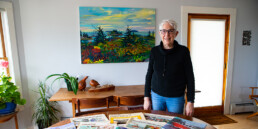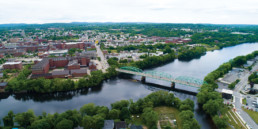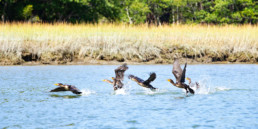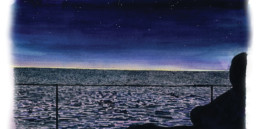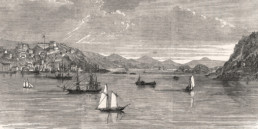Storm Tide, Robert Henri, 1903. Oil on canvas, 26 x 32 inches
Whitney Museum of American Art
Henri, Bellows, and Luks:
The Ashcan School in Maine
Painters found in our waters the realism they’d seen in cities
By Carl Little
At the end of the 19th century, something of a battle began in American art, between the academicians and a group of independent artists. The former, represented by the National Academy of Design in New York City, encouraged a rather genteel approach to painting: portraits, landscapes, and still lifes meant to please the public, but little else. Impressionism and academic realism ruled the aesthetic roost.
The independents, led by the charismatic Robert Henri (pronounced hen-rye), for the most part rejected this decorous approach, in style and subject. Many of them painted boldly, inspired by Henri’s charge to make every brush stroke count. As he wrote in The Art Spirit (1923): “The mere brush stroke itself must speak… It is on the canvas and it tells its tale.”
While they produced their share of society portraits and comely landscapes, these “individualists” also embraced the grittier side of everyday working-class city life: rag pickers and waifs, tenements and railyards, bars and boxing matches. Their choice of subject matter earned them the title “Ashcan School,” a label that started out as a reproach and ended up being something of a badge of honor.
In many art-historical accounts of the Ashcan School, little mention is made of the work several of its members created in Maine. More significantly, rarely have historians delved into how that work connected to their unfiltered vision of the city.
Henri was the first to venture north and east, visiting Boothbay Harbor and Monhegan in 1903. While drawn to the primal elements of the Maine coast—crashing waves and bold headlands—the artist also furthered his Ashcan School perspective.
In Storm Tide, 1903, a figure stands by the open doorway of a shack on stilts, facing the onslaught of wind-driven waves. The simple shoreline structures are the Maine coast equivalent of the poor sections of New York; the woman shielding her face with her arm is kin to the figures in Ashcan School portraits of city residents living on the edge of indigence.
Henri famously encouraged his students to visit Maine, and specifically Monhegan, and a number of artists heeded the call, including Rockwell Kent, Edward Hopper, and George Bellows. The last-named is considered by some art historians to be a “second generation” Ashcan School painter as he came into the fold later on. That he belongs in their company is undeniable: From his famous boxing paintings to his images of the Lower East Side, Bellows cast an unsentimental eye on the big city.
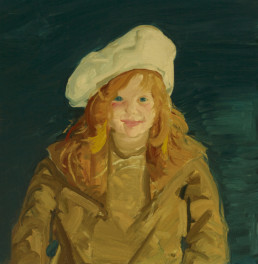
Portrait of Jacqueline Hudson, George Bellows, 1914. Oil on panel, 24½ x 24¾ inches
Collection of Monhegan Museum of Art & History, gift of Susan Bateson and Stephen S. Fuller in honor of Edward L. Deci, director of the museum 1984-2019
Like Henri, Bellows brought his Ashcan School sensibility to bear on some of his Maine paintings. For one, he wielded a swift and sure brush, fulfilling his teacher’s definition of the true artist as one who, in viewing the landscape, “renders it upon his canvas as a living thing.”
Bellows also embraced the working waterfront, paying tribute to the fishermen he found on Monhegan in such iconic canvases as The Big Dory (1913). His paintings of the wharves on Matinicus and Criehaven and of ships and docks being built in Camden document their unruly glory. As the painter stated in 1917, “It seems to me that an artist must be a spectator of life; a reverential, enthusiastic, emotional spectator.”
Bellows’ portrait of the four-year-old Jacqueline Hudson, thought to have been painted in the Monhegan home of her father, artist Eric Hudson, displays that wonderful empathy found in so many Ashcan School images of city children. Acquired last year by the Monhegan Museum of Art and History, the painting shows the smiling red-haired girl in a brown coat and out-sized beret, as ragamuffin as any street urchin.
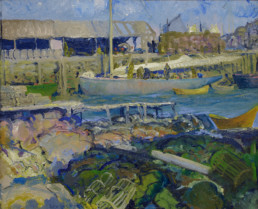
The Fish Wharf, Matinicus Island, George Bellows, 1916
Farnsworth Art Museum
Of the Ashcan School painters who came to Maine, George Luks is the most overlooked: He does not appear in any historical survey, including the landmark Maine and its Role in American Art, 1740-1963. While it’s true he apparently spent only part of the summer of 1922 in the state, considering his exceptional production while in residence, the omission is somewhat remarkable.
Born in Williamsport, Pennsylvania, in 1867, Luks developed a humanist outlook through his family’s interactions with coal miners. He moved to Philadelphia where he met and came under the sway of Henri. As art historian Judith O’Toole has noted, Luks was “profoundly influenced” by his mentor’s philosophy, “especially his directive to paint ordinary life and shun the conventional subjects of the genteel tradition.” He also followed Henri’s demand “to execute a painting quickly and with great speed.”
Upon settling in New York City, Luks established himself as an important independent painter. He wandered poor neighborhoods making sketches that later became empathetic images of street life. His acclaimed The Spielers, 1905, a portrait of two immigrant children dancing, epitomizes what O’Toole calls his “ruthless realism.”
In 1919, Luks traveled to Nova Scotia. He turned to watercolor to capture the northern landscape, which included lively renderings of rivers and trout-fishing around Lake Rossignol, a reservoir in the southwestern part of the province. These brilliant paintings, some of which led to oils, inspired critics to signal a revival of his reputation and a further advancement toward the status of old master.
The year 1922 proved to be somewhat tumultuous. Luks contracted a severe illness, perhaps related to his drinking, that sent him to a sanitorium. Fortunately for him, his friend and patron, socialite and sculptor Margaret Sargent, invited him to stay in her Boston mansion.
That summer Luks visited Maine. In an essay for a Luks retrospective at the Sordoni Art Gallery in 1987, art historian Stanley Cuba recounts how the painter settled in “a little old farmhouse” on Pond Cove in Cape Elizabeth. According to Cuba, Luks had first seen the area when taking the ferry to Nova Scotia from Portland three years earlier.
Luks’s reaction to the Maine coast expresses the kind of enthusiasm found in the letters and writings of Henri, Bellows, Kent, and others upon their introduction to this northern realm. In an article titled “George Luks, Noted Artist and Philosopher, Says Maine Leads Them All in Scenery” written by Emma Moseley for the Portland Evening Express, the painter waxed lyric about his surroundings:
Talk about the chalk cliffs of Cornish, talk about the “wonderful scenery” anywhere in Europe, Maine has it over them. Here you have that wonderful gray that is found only in such a climate as that of Maine and your rocks and shores are so rugged and bold they make other rocks and shores seem pretty and puny in comparison; and your characters, there are real American types here, types that you find nowhere else… I intend to paint them in all their strength and ruggedness, and I shall be happy as a king for I shall find plenty of material here with which I can work.
And he did: In a letter dated Sept. 3, 1922, to one of his former students, Mildred Williams, Luks reports returning from Maine with 15 canvases. Several of his paintings feature fishermen and farmers in and around Cape Elizabeth.
In Henry Dyer, Cape Elizabeth, the farmer of the title, seated on a riding cultivator, guides his horses across a field overlooking the sea. Interesting to note that the Dyer family farm is part of an agricultural conservation easement recently arranged by Maine Farmland Trust and the Cape Elizabeth Land Trust that ensures the property will remain available for agriculture in perpetuity. According to the Portland Press Herald, the Maxwell Farm-Dyer Field is “the largest, permanently preserved farm parcel closest to Portland.”
In both Henry Dyer, Cape Elizabeth, and Hannaford’s Cove, Cape Elizabeth, Two Lights can be seen in the distance. In the latter painting, the lighthouse, which would later become the subject of iconic paintings by Edward Hopper and Andrew Winter, provides the backdrop for two fishermen hauling their boat up onto the rocky beach, their “strength and ruggedness” on full display.
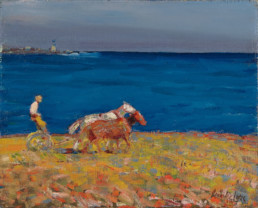
Henry Dyer, Cape Elizabeth, George Luks, 1922
What is perhaps Luks’s greatest Maine painting is a view of Poverty Hump, a small wave-beaten outpost in the Muscle Ridge Shoals off of South Thomaston. Two men have landed a boat on bare ledge. While one of them unloads the boat, the other makes his way up the rocky terrain carrying something over his shoulder, headed for three shacks and a ragged orange pennant blowing in the wind, perhaps a makeshift storm warning flag or marker to keep passing ships from hitting the island.
The painting is executed with gusto, the brush strokes deployed with brilliant force and vitality. The scene is dramatic, in setting and color scheme, even as it records an episode of Maine coast life.
Ben Fuller, Penobscot Marine Museum curator, monitors this section of the coast for the Maine Island Trail Association and believes the painting depicts some ledges/bars “just south of Dix [Island] or possibly one of the rocks in the Clam ledges.” He further notes: “If it is where I think it is, you are seeing the mainland, the Camden Hills, in the background to the left of the breaking wave. With any kind of southerly blowing up the channel, you would get breaking waves there.”
The diminutive “hump” doesn’t appear in Charles McLane’s Islands of the Mid-Maine Coast, but in his description of the Muscle Ridge islands, he notes that several served as seasonal residences for local fishermen around this time. Fuller feels that with “decent connections to Rockland, it would not have been hard for an artist to get into the Muscle Ridge and find a spot to bunk for a bit.”
An authority on Maine boats, Fuller believes the craft in the painting might be a flat bottom skiff. “The sheer seems a little exaggerated towards the bow,” he explains, and “given license it looks like the boat’s transom is too wide for it to be some kind of dory.” Such small craft, he notes, would be found around weirs, of which there were a number in the area at the time Luks visited. He suspects the men are resupplying the shacks.
“As I recall, there are still a few huts or camps like this on at least one of the Clam islands south of Dix.”
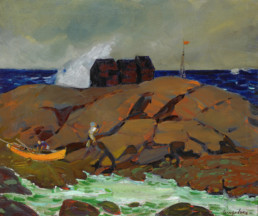
Poverty Hump, Maine, George Luks, ca. 1922. Oil on canvas, 25 x 30 inches
Luks’s Maine paintings were shown at the Kraushaar Gallery in New York City in October 1922 and received positive critical notice. A reviewer for The Christian Science Monitor wrote, “Mr. Luks, like other artists, has marveled at the conflict of the giant ledges valiantly withstanding the onslaughts of the sea, but he has, unlike the majority of his confreres, transferred to his canvases the sense of the contrasting forces and the grandeur of these Titans.” The critic also remarked on his colors, “the beautiful, pale vermillion dory being dragged ashore or the burnt-sienna seaweed clinging to the exposed rocks.”
Like Bellows and Henri, Luks managed to make the move from urban to rural realist. In search of subject matter that reflected the truth of life in America, these Ashcan School painters found a major muse in Maine.
Carl Little’s books include Edward Hopper’s New England, The Art of Maine in Winter, and Paintings of Portland, co-authored with his brother David. He has published monographs on a number of Maine artists, including Philip Barter, Dahlov Ipcar, Eric Hopkins and Beverly Hallam. His articles appear in Art New England, The Working Waterfront and Maine Boats, Homes & Harbors. He lives and writes on Mount Desert Island.

